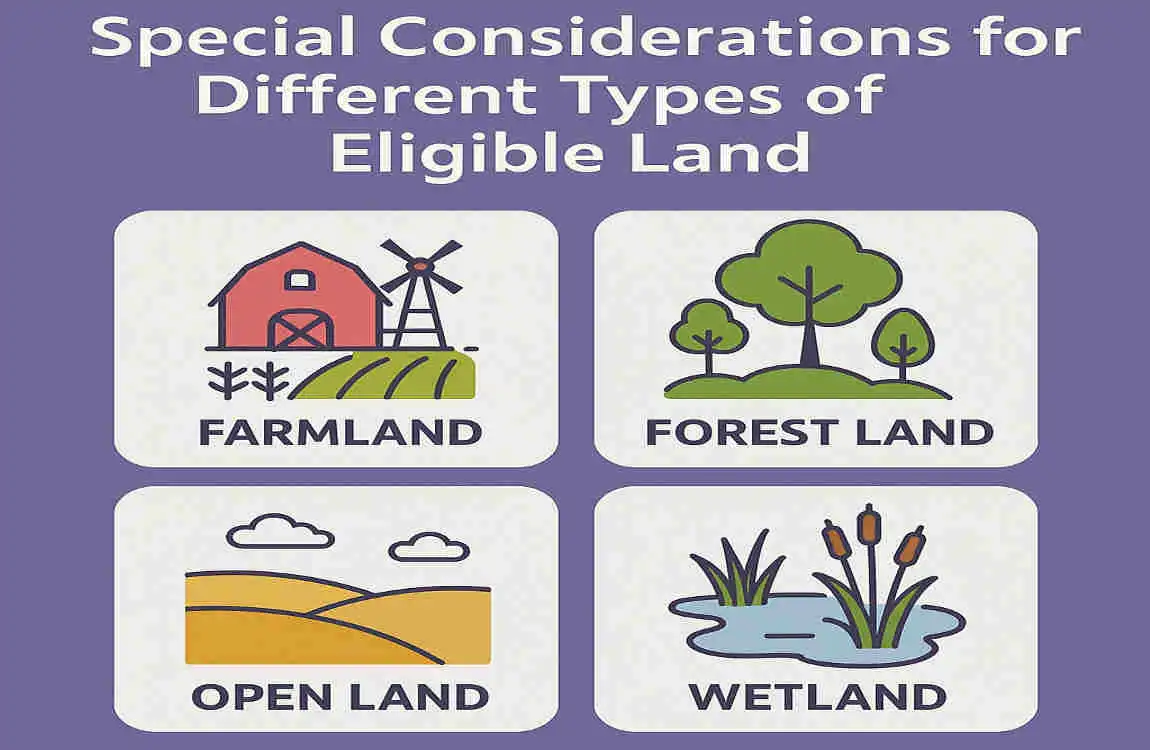Choosing the correct type of land for building your dream home is a big decision. It’s not just about finding a pretty plot; you need to make sure the land is eligible for residential construction. So, what type of land can you build a house on?
Understanding Land Types for Residential Construction

Before we dive into the specifics of zoning and regulations, let’s start with the basics. Land can be categorized into several types, each with its own set of rules and restrictions for building a house.
Types of Land
- Residential Land: This is land explicitly zoned for residential use, making it the most straightforward choice for building a house.
- Commercial Land: Typically used for businesses, offices, and retail spaces, commercial land usually has restrictions on residential construction.
- Agricultural Land: Primarily used for farming, building a house on this type of land may require special permits or rezoning.
- Industrial Land: Reserved for manufacturing, warehousing, and other industrial activities, industrial land is rarely eligible for residential construction.
- Vacant or Raw Land: Land that has not been developed or improved, which may require additional steps to determine its buildability.
Buildable vs. Non-Buildable Land
Not all land is created equal when it comes to building a house. Buildable land meets the necessary criteria for residential construction, while non-buildable land faces restrictions or limitations that make it unsuitable for building.
Several factors influence whether a piece of land is buildable:
- Land Topography: The shape and slope of the land can impact construction costs and feasibility.
- Soil Quality and Stability: Soil type and its ability to support a foundation are crucial to safe, stable construction.
- Flood Zones and Environmental Restrictions: Land located in flood-prone areas or protected by environmental regulations may be subject to building restrictions.
To determine if a piece of land is buildable, it’s essential to conduct land surveys and soil tests early in the process. These assessments will help you understand the land’s potential and any challenges you may face during construction.
What Type of Land Can You Build a House On? — Land Zoning Explained
Now that we’ve covered the basics of land types, let’s explore the critical role of zoning in determining what kind of land you can build a house on.
What is Zoning?
Zoning is a system of land use regulations that governs how land can be used within a specific area. It’s designed to ensure orderly development, protect property values, and maintain a community’s character. Zoning plays a significant role in determining whether you can build a house on a particular piece of land.
Key Zoning Categories for Residential Building
When it comes to building a house, the following zoning categories are most relevant:
Residential Zones
- Single-Family Zones: Designed for single-family homes, these zones typically have strict regulations on lot size, setbacks, and building height.
- Multi-Family Zones: Allow for the construction of apartments, townhouses, and other multi-family dwellings.
- Mixed-Use Zones: Permit a combination of residential and commercial uses, often found in urban areas.
Agricultural Zones
- While primarily intended for farming, some agricultural zones allow for the construction of a single-family home, subject to certain conditions and permits.
Commercial and Industrial Zones
- Generally restricted to housing, these zones prioritize business and industrial activities.
Un zoned or Special Purpose Zones
- Some areas may lack formal zoning or be designated for specific purposes, such as conservation or recreation.
Checking Zoning in Your Area
To determine the zoning of a specific piece of land, you can:
- Visit your local municipal website and access zoning maps or ordinances.
- Contact your local planning or zoning department for information and guidance.
- Consult with a real estate professional or land use attorney familiar with your area.
What to Do If Land Is Not Zoned for Residential Use
If you find a piece of land that you love but it’s not zoned for residential use, don’t lose hope just yet. You may be able to apply for a rezoning or seek a variance to allow for residential construction. The process can be complex and time-consuming, so it’s essential to work with professionals who understand local regulations and procedures.
Examples of Zoning Restrictions
Zoning can impact various aspects of house construction, including:
- Setbacks: The minimum distance required between a structure and property lines or other buildings.
- Height Limits: Restrictions on the maximum height of a building.
- Density: Regulations on the number of units or homes allowed per acre.
Understanding these zoning restrictions and how they apply to your chosen piece of land is crucial for planning your home construction project.
Legal and Regulatory Requirements for Building a House on Land
Once you’ve determined that your land is zoned for residential use, you’ll need to navigate the legal and regulatory requirements for building a house. These requirements can vary by location, but some common elements include:
Permits and Approvals
Before breaking ground, you’ll need to secure various permits and approvals, such as:
- Building Permits: Issued by your local building department, these permits ensure that your construction plans meet local codes and regulations.
- Environmental Impact Assessments: Required in some cases to evaluate the potential environmental impact of your project.
- Easements and Rights-of-Way: Considerations for access to utilities, roads, or neighboring properties.
Local Regulations
In addition to zoning, local regulations may include:
- Minimum Lot Size and Frontage Requirements: Ensuring that your land meets the necessary size and street frontage for residential construction.
- Homeowners Association (HOA) Rules and Covenants: If your land is part of an HOA, you may face additional restrictions on building and design.
Building Codes and Inspections
State, county, and local building codes govern construction and ensure your home meets safety and quality standards. Throughout the construction process, you’ll need to schedule inspections to verify compliance with these codes.
Consequences of Ignoring Zoning and Regulations
Failing to adhere to zoning and regulations can have serious consequences, including:
- Legal Risks: Fines, penalties, or even court orders to stop construction or demolish an illegally built structure.
- Financial Risks: Delays, additional costs, and the potential loss of your investment.
- Safety Risks: Building without proper permits and inspections can compromise the safety and structural integrity of your home.
By understanding and complying with legal and regulatory requirements, you can ensure a smooth, successful home construction process.
Special Considerations for Different Types of Eligible Land

While some types of land may be more straightforward for residential construction, others require special considerations. Let’s explore some of these unique situations:
Building on Agricultural Land vs. Residential Land
If you’re considering building on agricultural land, keep in mind:
- Limitations and Conversions: You may need to convert the land from agricultural to residential use, which can involve additional steps and costs.
- Taxes and Subsidies: Agricultural land may have different tax implications and potential subsidies that could impact your decision.
Challenges of Building on Raw/Vacant Land
Building on raw or vacant land can be more complex due to:
- Lack of Infrastructure: You may need to invest in bringing utilities, roads, and other essential services to the property.
- Environmental Concerns: Raw land may have environmental constraints or require additional permits and assessments.
Land with Environmental Constraints
If your chosen land falls within a wetland, floodplain, or protected area, you’ll need to consider:
- Special Permits and Regulations: Building in these areas often requires additional permits and adherence to specific environmental regulations.
- Mitigation Measures: You may need to implement measures to minimize the impact of your construction on the surrounding environment.
Urban vs. Rural Land for Home Construction
When deciding between urban and rural land, consider:
- Benefits and Restrictions: Urban land may offer easier access to amenities and services, but with more stringent zoning and regulations. Rural land can provide more space and privacy, but may require additional infrastructure.
- Accessibility and Infrastructure: Evaluate the availability of roads, utilities, and water supply when choosing between urban and rural locations.
By understanding these special considerations, you can make an informed decision about the type of land that best suits your needs and budget.
Steps to Verify Land Eligibility Before Buying
Before you make an offer on a piece of land, it’s crucial to verify its eligibility for building a house. Here are some steps to guide your due diligence:
Research Zoning and Land Use Designations
- Consult local zoning maps and ordinances to confirm the land’s zoning and any restrictions on residential construction.
- Research any planned changes or developments in the area that could impact your ability to build.
Consult with Local Planning or Zoning Departments
- Reach out to your local planning or zoning department for guidance on the land’s eligibility and any additional requirements.
- Ask about the process for obtaining necessary permits and approvals.
Hire Professionals
- Engage a surveyor to assess the land’s boundaries, topography, and any potential issues.
- Consult with a land-use attorney or a real estate professional familiar with local regulations.
- Work with an architect or builder to evaluate the land’s suitability for your desired home design.
Visit the Property and the Surrounding Neighborhood
- Walk the land to assess its condition, accessibility, and any potential challenges.
- Explore the surrounding neighborhood to gauge the area’s character and compatibility with your vision.
Questions to Ask Sellers or Real Estate Agents
When inquiring about a piece of land, ask:
- Is the land zoned for residential use?
- Are there any known restrictions or limitations on building?
- Have any surveys or assessments been conducted on the property?
- Are there any ongoing or planned developments in the area?
Tools and Resources for Land Research
Take advantage of online resources to aid your research:
- GIS Maps: Geographic Information System (GIS) maps can provide valuable data on zoning, flood zones, and other land characteristics.
- Zoning Portals: Many municipalities offer online portals to access zoning information and submit inquiries.
- Real Estate Websites: Some real estate websites provide detailed information on land listings, including zoning and other relevant data.
By following these steps and utilizing the available resources, you can make an informed decision about the land’s eligibility for building your dream home.
Tips for Navigating Zoning Challenges and Securing Build Approval
Even if you’ve found a piece of land that seems perfect, you may still face challenges in securing the necessary building approvals. Here are some tips to help you navigate the process:
Work with city Planners and Zoning Boards
- Establish a positive relationship with local planners and zoning board members to gain insight into the approval process.
- Attend public meetings and hearings to stay informed about zoning decisions and potential changes.
Apply for Variances, Exceptions, or Rezoning
- If your land doesn’t meet current zoning requirements, consider applying for a variance or exception to allow for residential construction.
- In some cases, you may need to pursue rezoning to change the land’s designation to residential use.
Prepare Well-Documented Site Plans
- Work with professionals to create detailed site plans that demonstrate compliance with zoning and regulations.
- Include information on setbacks, lot coverage, and other relevant factors to support your case for approval.
Utilize Professional Help
- Engage a land use attorney or consultant to guide you through the approval process and represent your interests.
- Work with an experienced architect or builder who understands local regulations and can help design a compliant home.
By following these tips and collaborating with local authorities and professionals, you can increase your chances of successfully navigating zoning challenges and securing the approvals needed to build your dream home.




